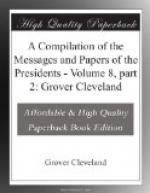John Quincy Adams.
Washington,
December 27, 1825
To the House of Representatives of the United States:
In compliance with a resolution of the House of Representatives of the 23d instant, I transmit herewith a report from the Secretary of War, with the correspondence between the Department of War and Generals Pinckney and Jackson, and all the instructions given to the said Generals Pinckney and Jackson relating to the treaty with the Creek Indians, afterwards made at Fort Jackson, so far as the same can be communicated without prejudice to the public interest.
John Quincy Adams.
Washington,
January 3, 1826
To the House of Representatives of the United States:
In compliance with a resolution of the House of Representatives of the 23d of last month, I communicate herewith a report from the Secretary of War, with the documents touching the treaty with the Cherokee Indians, ratified in 1819, by which the Cherokee title to a portion of lands within the limits of North Carolina was extinguished.
John Quincy Adams.
Washington,
January 9, 1826
To the Senate of the United States:
In compliance with a resolution of the Senate of the 3d instant, I communicate herewith, in confidence, a report[002] from the Secretary of State, with translations of the conventions and documents, containing information of the nature referred to in the said resolution.
John Quincy Adams.
Washington,
January 9, 1826
To the Senate of the United States:
I transmit to the Senate, for their consideration and advice with regard to the ratification, the following treaties:
1. A treaty signed at the Poncar village at the mouth of White Point Creek, the first below the Qui Carre River, on the 9th of June, 1825, by Brigadier-General Henry Atkinson and Major Benjamin O’Fallon, commissioners on the part of the United States, and certain chiefs, headmen, and warriors of the Poncar tribe of Indians on the part of said tribe.
2. A treaty signed at Fort Look-out, near the Three Rivers of the Sioux Pass, on the 22d June, 1825, by the same commissioners on the part of the United States and certain chiefs, headmen, and warriors of the Teton, Yancton, and Yanctonies bands of the Sioux tribe of Indians on the part of the said bands.
3. A treaty signed at the mouth of the Teton River on the 5th of July, 1825, by the same commissioners on the part of the United States and by certain chiefs, headmen, and warriors of the Sione and Ogalla bands of Sioux Indians, and on the 12th of July, 1825, at Camp Hidden Creek, by chiefs and warriors of the Siounes of the Fireheart’s band on the part of their respective bands.
4. A treaty signed at the mouth of the Teton River on the 6th of July, 1825, by the same commissioners on the part of the United States and by certain chiefs, headmen, and warriors of the Chayenne tribe of Indians on the part of said tribe.




